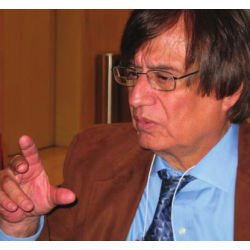
No one was surprised, certainly not those of us who sit in science and engineering faculty meetings as the only underrepresented minority in the room, by Donna Nelson’s recent study results—the second edition of which was released this January1—of tenured and tenure track faculty in the top science and engineering departments (as ranked by the U.S. National Science Foundation according to research funds expended.). Nelson concludes “There are relatively few tenured and tenure-track underrepresented minority (URM) faculty in these research university departments, even though a growing number and percentage of minorities are completing their Ph.D.s. Qualified minorities are not going to faculties of many science and engineering disciplines.” While computer science had the lowest percentage of URM professors in 2002, other disciplines, noticeably math and physics, grew increasingly worse in the ensuing five years to equal this distinction (see http://chem.ou.edu/~djn/diversity/Faculty_Tables_FY07/07Report.pdf for the complete data set from the second edition of the report).
Importance of Minority Faculty at Research Universities
Nelson makes a strong point in her report on the importance to the university and to the discipline of having minority faculty. She says, “Dearth of minority faculty at a university or in a discipline discourages minority students from selecting that university or discipline, since most students are comfortable in environments that include people with backgrounds and characteristics similar to theirs.”1 Students who do choose the discipline need role models and mentors to inspire, motivate, and encourage them.
Over the years at Rice University, I have directed or co-directed 23 URMs or women Ph.D. doctoral recipients in Computational and Applied mathematics and lead an NSF Alliance for Graduate Education and the Professoriate (AGEP) with approximately 65 URM students from across science and engineering. Each year I teach an advanced-level class in optimization theory in the engineering division. Minority students from the various engineering disciplines are invariably drawn to my class. They seem to be motivated to perform well, and usually do. Often a minority student is at the top of the class even though there are many excellent non-minority students in the class. A few years ago, I had 24 students in class and 12 were minority. Just think: 50% of the students in an advanced level class at a Tier 1 Research School were minorities.
As minority faculty we serve as role models in two directions. We demonstrate feasibility to the minority students and show the non-minorities that we as minorities can be excellent teachers and faculty. We promote understanding in components that nonminority faculty members cannot.
I want to make what I believe is an often-overlooked critical point about the importance of minority faculty at our best research universities. Leadership in science and engineering comes from top research institutions. I believe that much of my national leadership has been possible because I am a faculty member at a respected university with respected research credentials. I am often asked to speak to research university presidents, faculty members, and national government leaders about representation. They listen to me because they know that I have been there. We must have strong faculty representation at the nation’s leading universities in order to produce high quality URM scientists. Consequently, I strongly encourage us to create more programs and invest more funding with the goal of developing minority faculty at research universities.
What Won’t Work
There is a growing movement for Minority Serving Institutions (MSIs) to develop Ph.D. programs, but Ph.D.s produced at MSIs will not become faculty at top research universities. Top research universities choose faculty from Ph.D.s produced at top research universities. I am extremely concerned that this will produce a permanent underclass. If we underrepresented minorities are ever to be an equitable presence as faculty at our top-level schools, then our students must be schooled at those same institutions. This is a hard statement for me to make. I have great friends at MSIs for whom I have great admiration. Their students speak warmly of how confident and supported they felt in their experiences there. Research universities should learn from them how to nurture that kind of confidence, but MSIs should not expect to produce graduate programs of the same caliber that more than a hundred years of investment has produced at the nation’s top research universities. More about this topic can be found in my Chronicle of Higher Education article, “Minority Students and Research Universities: How to Overcome the ‘Mismatch’.”2
Also, filling faculty positions with foreign scholars—even those who are black, brown, or Spanish-speaking—does little to solve the problem of universities’ lack of success with Mexican-American, Puerto Rican, and black youth from across the U.S. People from places like Africa, Spain, or Latin America cannot be effective role models or mentors for African-Americans and Latinos who grew up in the U.S. In fact, it is not unusual for those scholars to view their domestic-minority counterparts negatively and to strongly resist being identified with them. Many international students were admitted to graduate school in the U.S. because they were highly competitive and the best students of their nations. Often the products of early academic tracking, they have had strong educational foundations and intense, specialized study in their fields.
Also, foreign scholars were not viewed as racially or ethnically different in their countries of origin and, from their formative years on, made to feel they were second-class citizens who did not belong in higher education or in leadership positions. So when we make those hires, we must understand that we are not doing our part to increase participation, or provide role models. A fuller development on this topic can be found in my Chronicle of Higher Education article, “True Diversity Doesn’t Come From Abroad.”3
The post-doc position may be the most critical step in either making or breaking a successful future in the academy.
Another mistake we often make is of exclusively working up the ladder rather than also starting at the top and working down: starting with K12 to increase the pool of bachelor’s degrees in science and engineering, for example. As a long-term solution, this is necessary, but we can’t wait for the next generation; we need to do something now that will have an immediate impact.
What Will Work
Universities have the responsibility to hire and promote minority faculty members, and if we take the role seriously, we could make a significant improvement over the next five years. Here are some steps that I think we need to take:
Put qualified people in strong post-doctorate positions. Graduate research advisors must take a role in finding a strong post-doc position for students with potential. After receiving my Ph.D. from UCLA, I was guided by David Sanchez, the only underrepresented minority faculty member at that time in the UCLA Mathematics Department, to a post-doctoral position at the University of Wisconsin. This intervention and guidance was probably the most important in my entire professional life. At Wisconsin, I was very fortunate that I got to work with some of the finest mathematicians in my area. I was fully integrated into the research program. Graduate advisors must elicit a commitment of that kind of relationship from the post-doc advisor and then check to see that it is happening. The post-doc position may be the most critical step in either making or breaking a successful future in the academy.
Reexamine hiring criteria. When top level departments hire new faculty, their number one criteria is the candidate’s potential to be the next Gauss or Turing. What we assess when we hire is not what we expect or need of all faculty. I will illustrate this point with a story. A few years back I was invited to the University of California Berkeley as a Regents Lecturer. I gave five different talks in five days. In my university-wide talk on diversity, I included a segment entitled “Why the Berkeley Math Department Would Never Hire Me.” The reason is that my potential for winning a Fields Medal in Mathematics is low, even though I have performed solid research that would get me tenure at essentially any university including Berkeley. As I went from talk to talk the minority graduate students followed me around like I was the Pied Piper of Hamelin. I told them that my next talk really was not for graduate students. They said they did not care and just wanted to interact with me. Simply stated, I would give Berkeley more than 99% of their faculty in the broad and complete sense. Of course, I would be promoted; I would give in so many components that the university values. At universities like Berkeley, the promotion criteria are much broader than the hiring criteria, and this is good for the university and the nation.
We can’t wait for the next generation; we need to do something now that will have an immediate impact.
At Rice in 2005 I was appointed University Professor, an honor bestowed upon only six individuals, including two Nobel Laureates, in its 100-year history. However, I did not gain this distinction for my research alone, but primarily for contributions in the other dimensions I have discussed. When I gave my acceptance speech I thanked Rice for being sufficiently progressive to allow me to do it my way. I stated that I hope this example serves to show young faculty members that there are various paths to the same place, not just one, and the other more non-traditional paths are important. The Berkeley Math Department would greatly benefit from hiring someone like me, but they are unwilling to break their traditional hiring culture. And Berkeley is of course, representative of other universities that follow the same course of action in hiring.
Mentor young faculty. The Nelson data shows a loss as members go through the tenure process, a heartbreaking failure. It is wrong to assume that beginning faculty members will understand faculty culture and what is expected of faculty members. They need someone who will be forthright with them about departmental expectations. Someone must warn them of the danger of being enticed away from research by too much leadership or outreach too soon. This mentoring must be proactive. Young minority faculty members frequently will not ask for help or express concern that there is any problem with their progress. A few years ago, the Rice Sociology Department denied tenure to a young minority woman claiming that her as yet unpublished book on minority K12 education was not up to par with their standards. Yet this book when published was extremely well received and allowed her to be hired with tenure at an excellent Tier 1 University. In talking to this woman, she told me she was shocked by the decision and thought the department was most happy with her research. She had not had sufficient communication with her chair. The loss to Rice was huge; this young woman was the primary mentor of Rice minority women undergraduates across campus. Many a tear was shed and much anger felt when she left. In another case, a minority faculty member was denied tenure because he had extremely poor teaching evaluations. He was hired from industry, and his research was solid, but he had not been sufficiently well mentored on the need for good teaching. Rice lost a valuable faculty member who could have been saved with proper mentoring. Just as industry has for new executives, many departments are now making new faculty mentoring a formal responsibility of caring senior faculty members, and more need to do so.
We often lament the condition of representation without providing suggestions for making changes. I hope the suggestions I’ve made here might be the impetus for discussions in departments across the U.S. I am keenly interested in this process and welcome participation in a national effort to improve representation of university science and engineering faculty.




Join the Discussion (0)
Become a Member or Sign In to Post a Comment